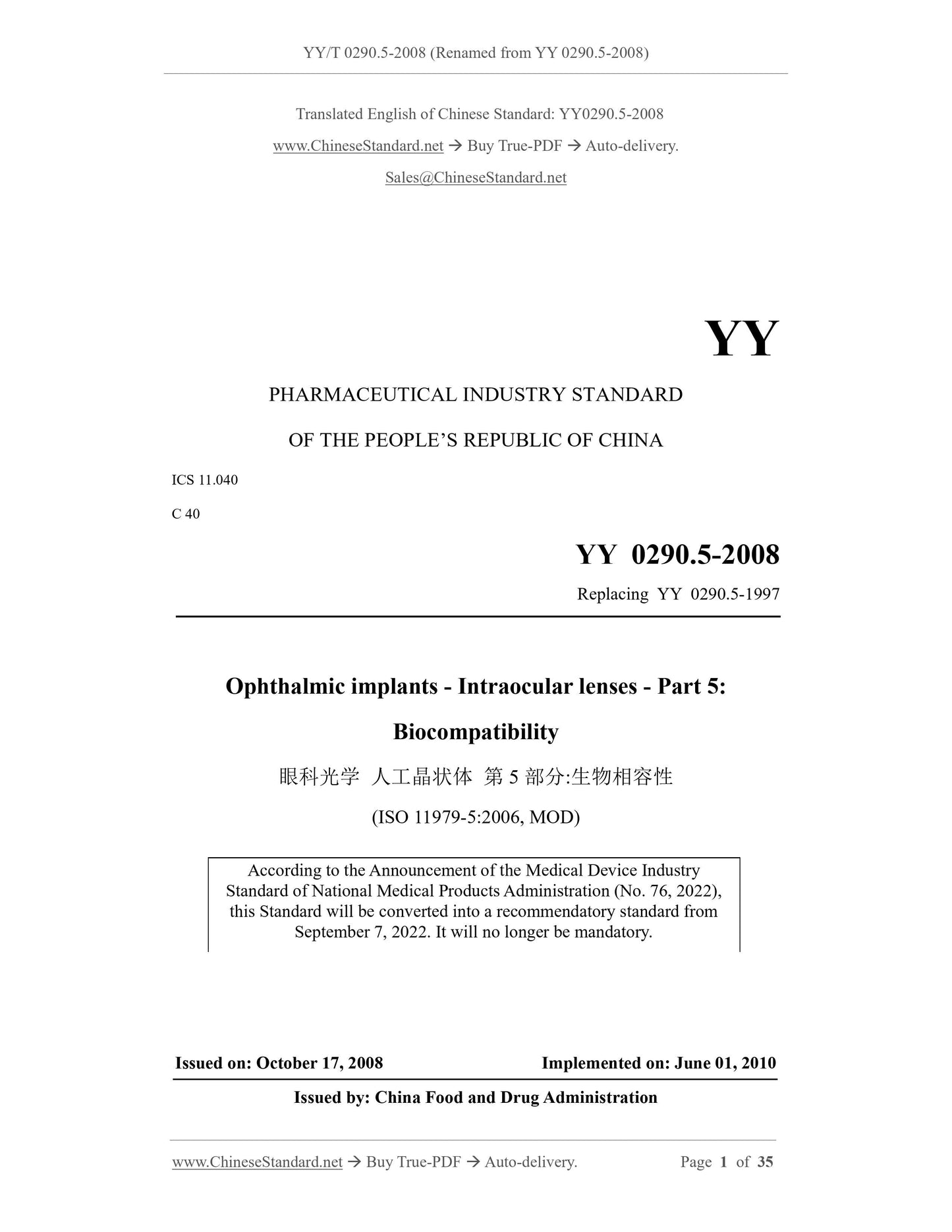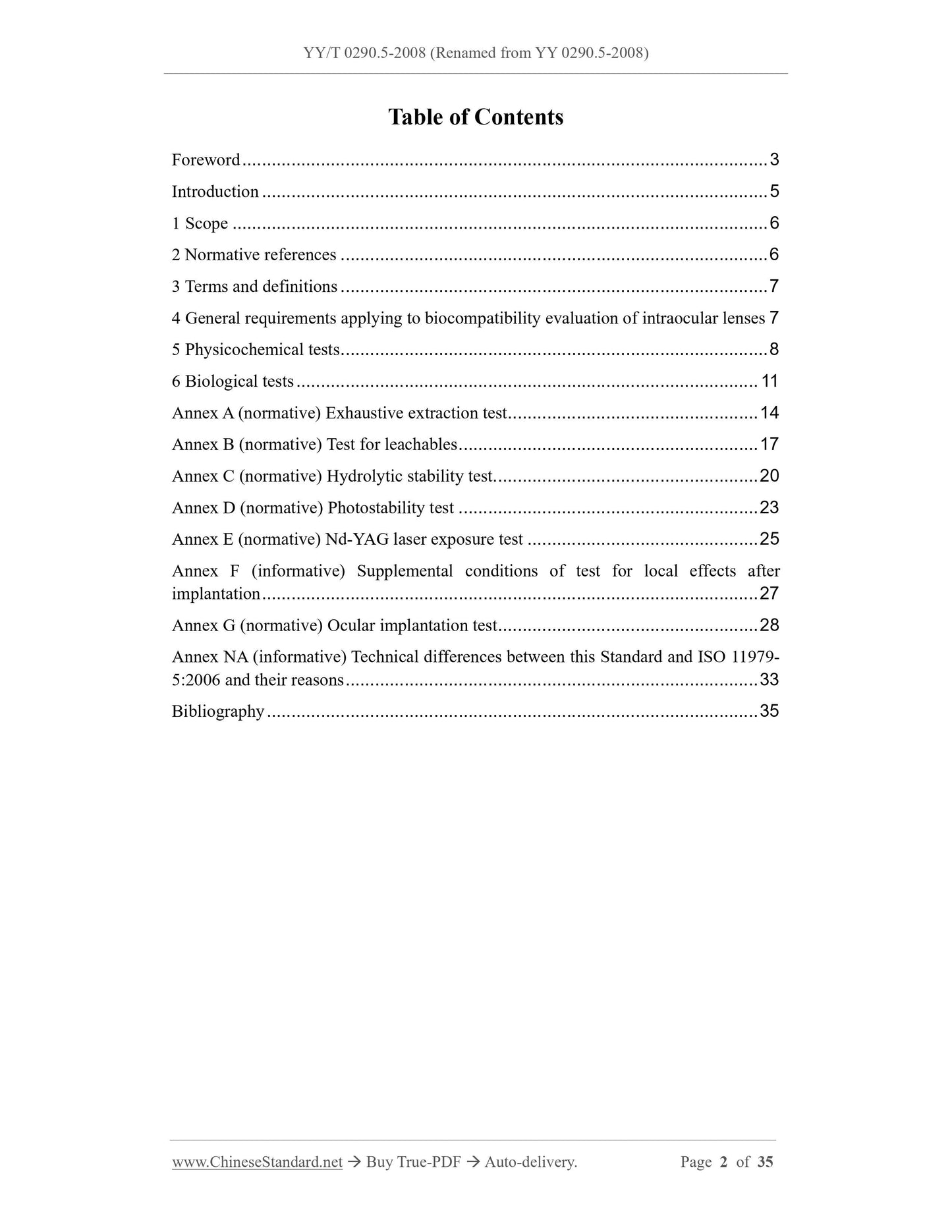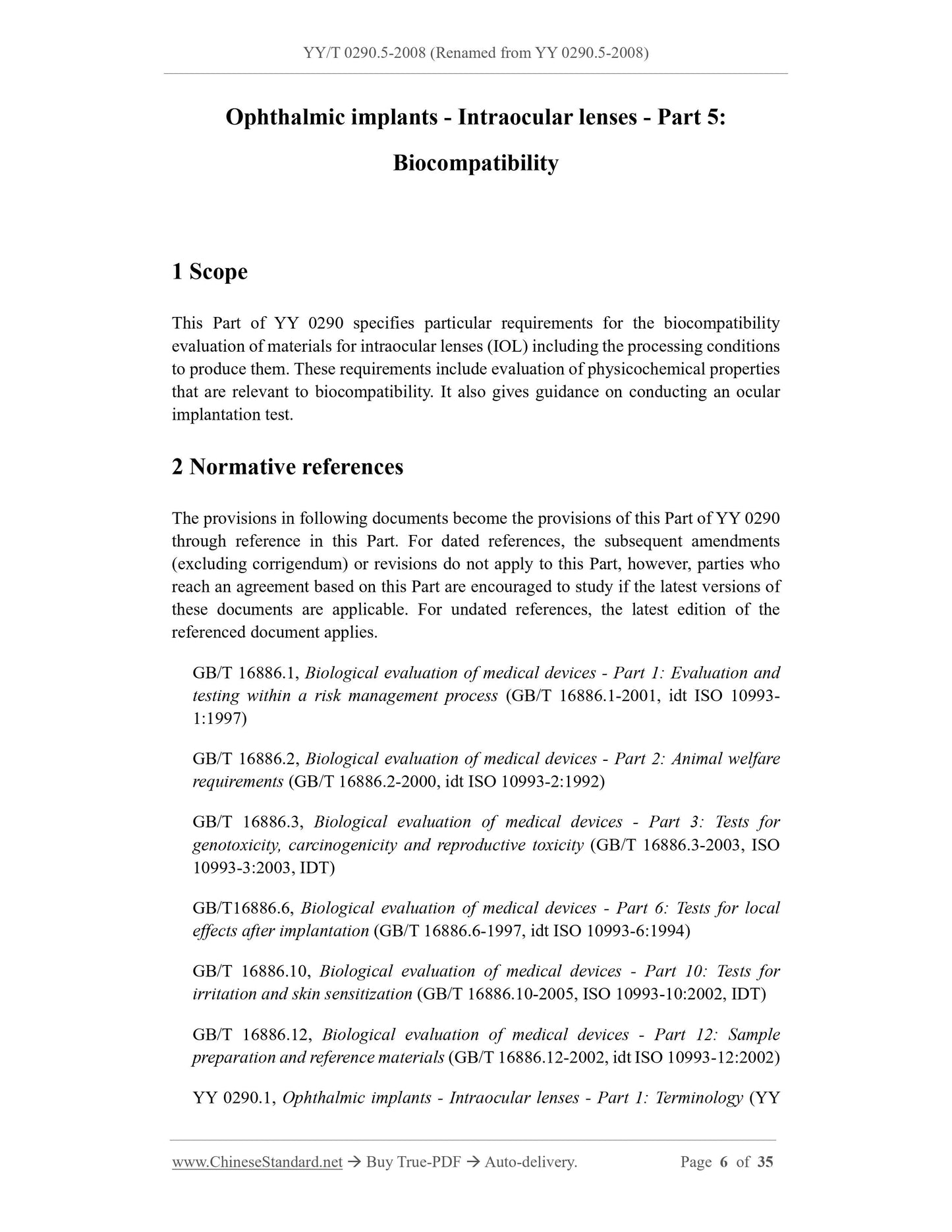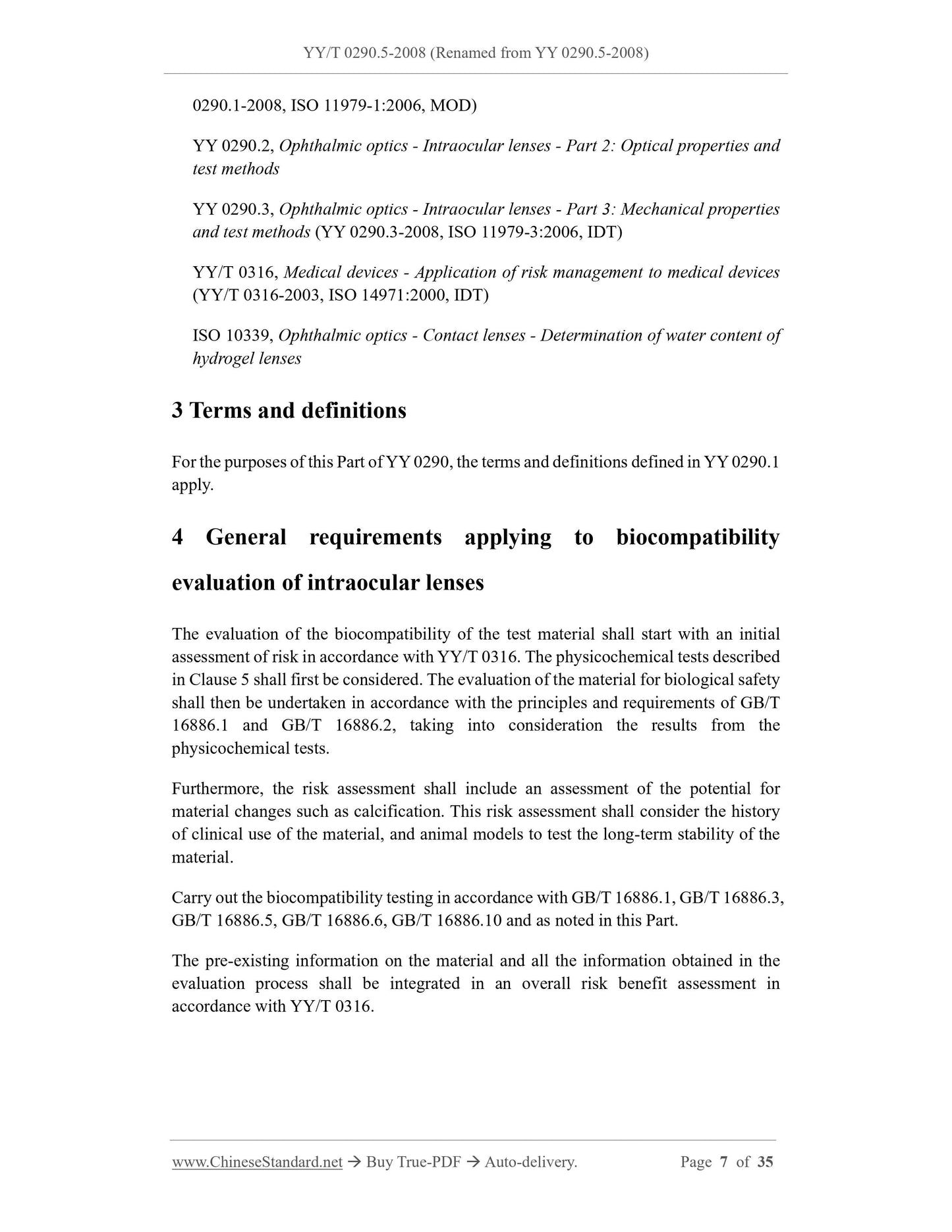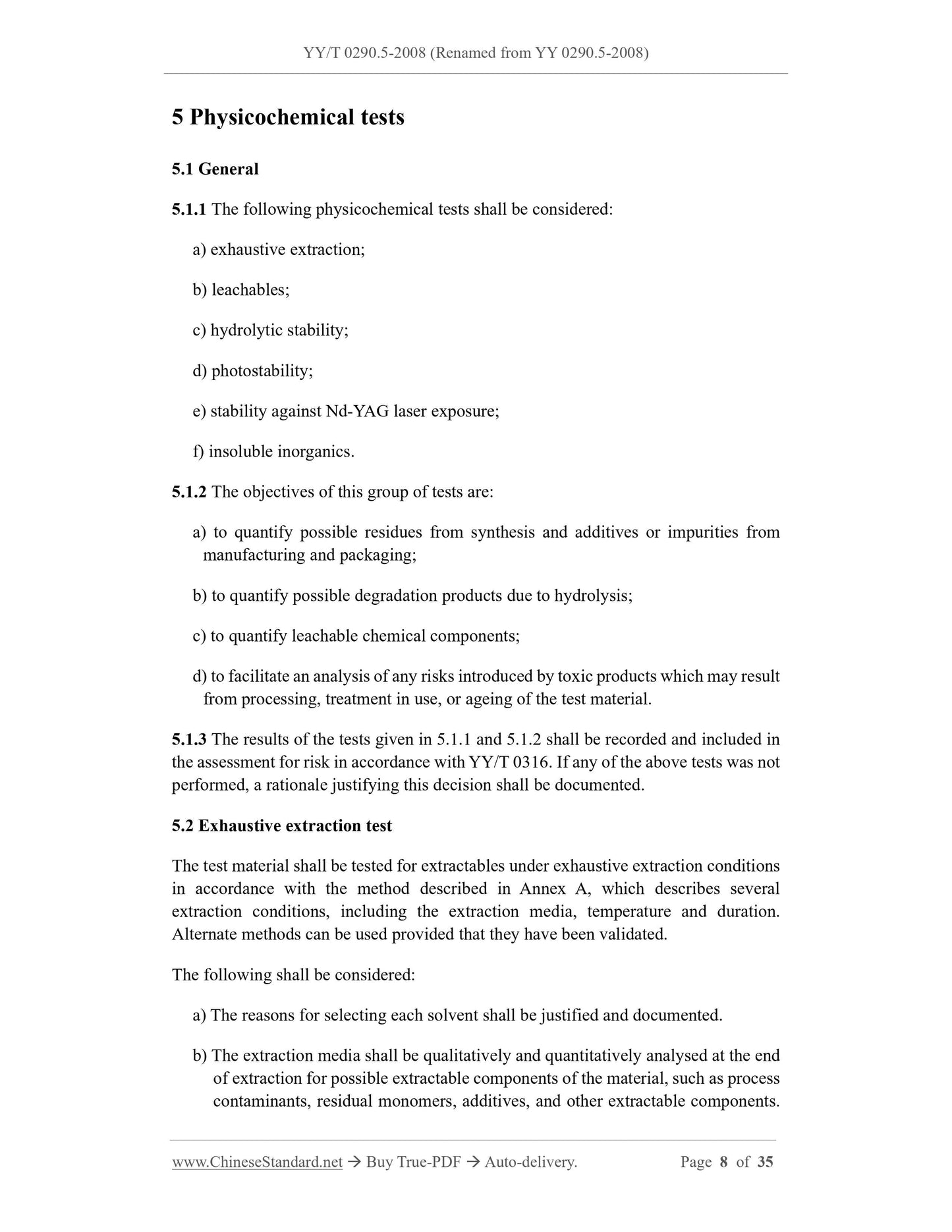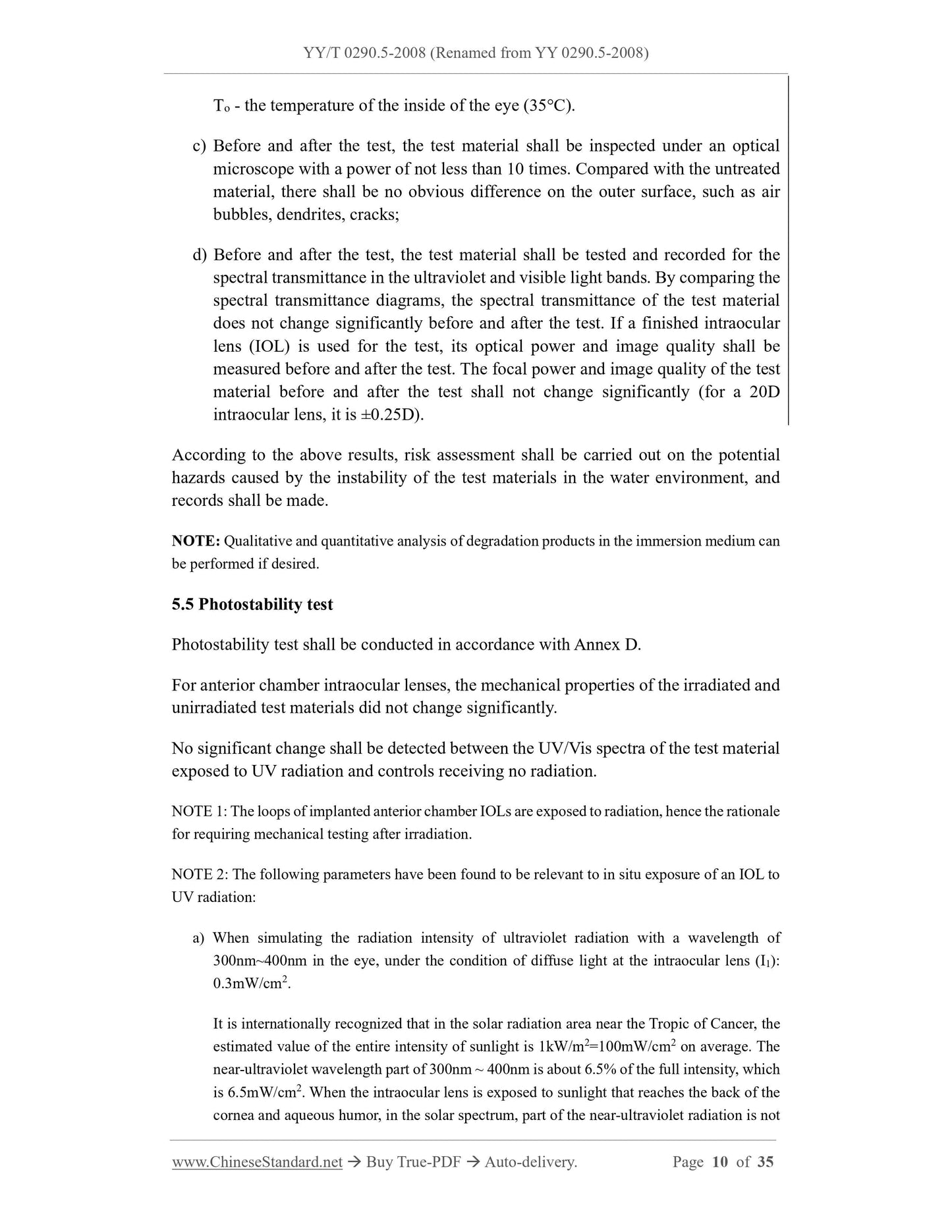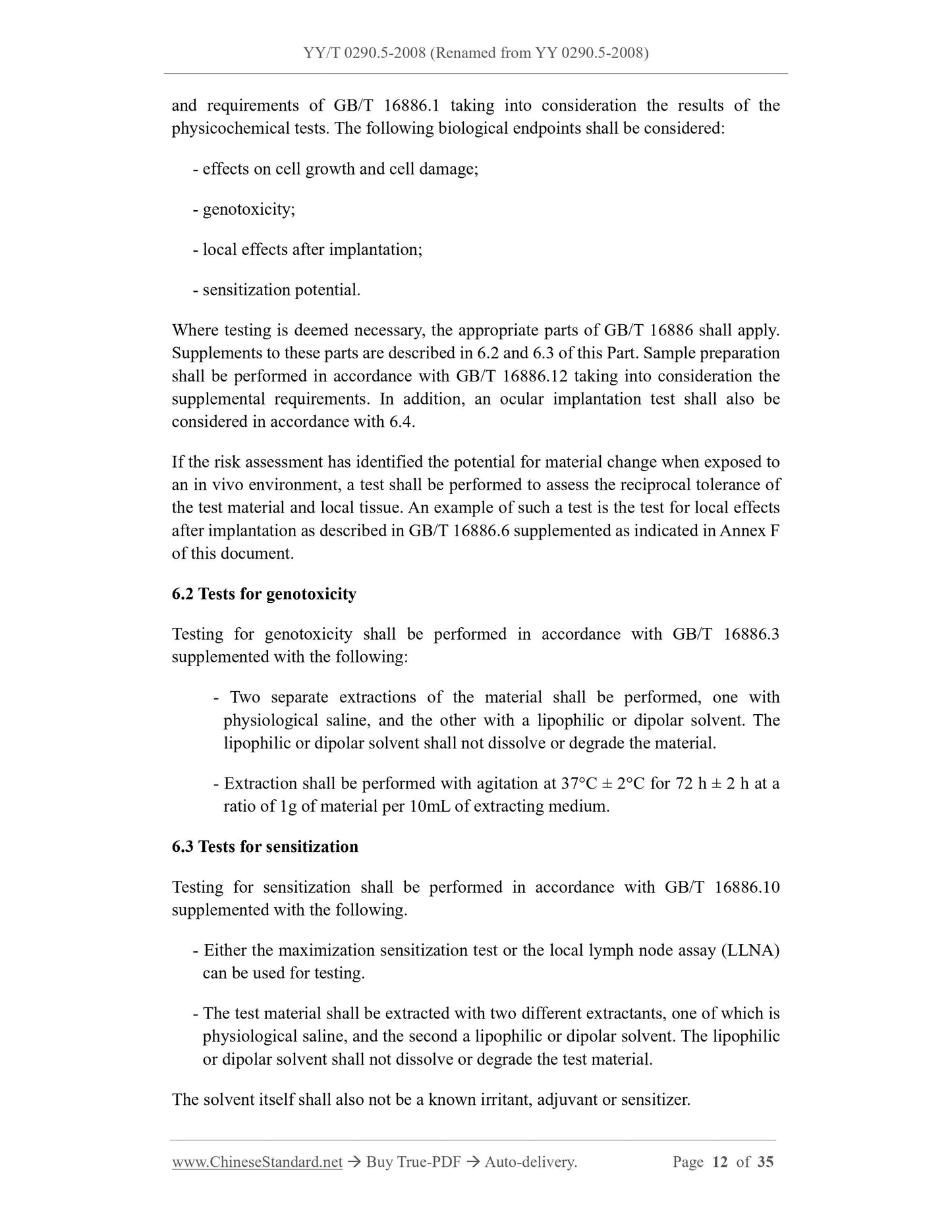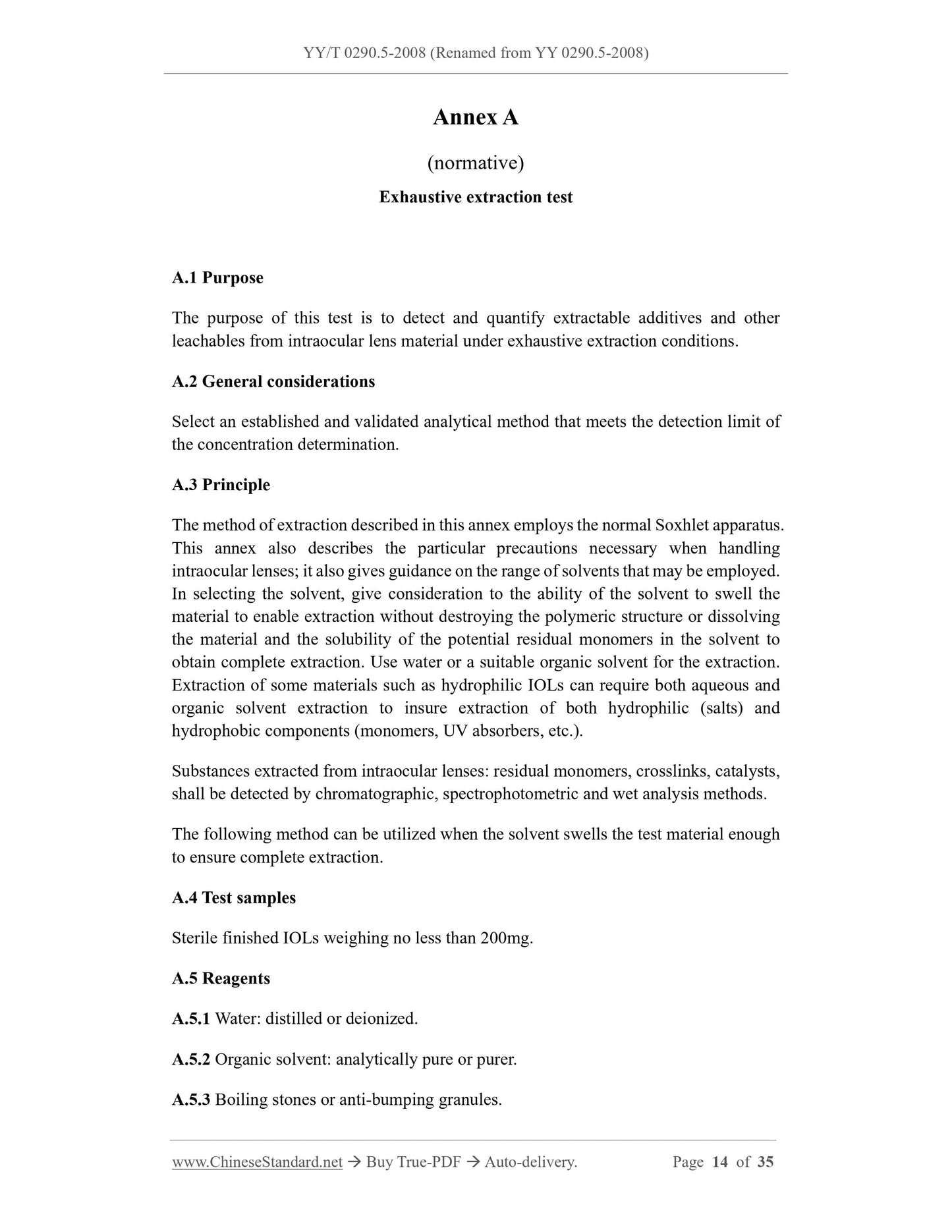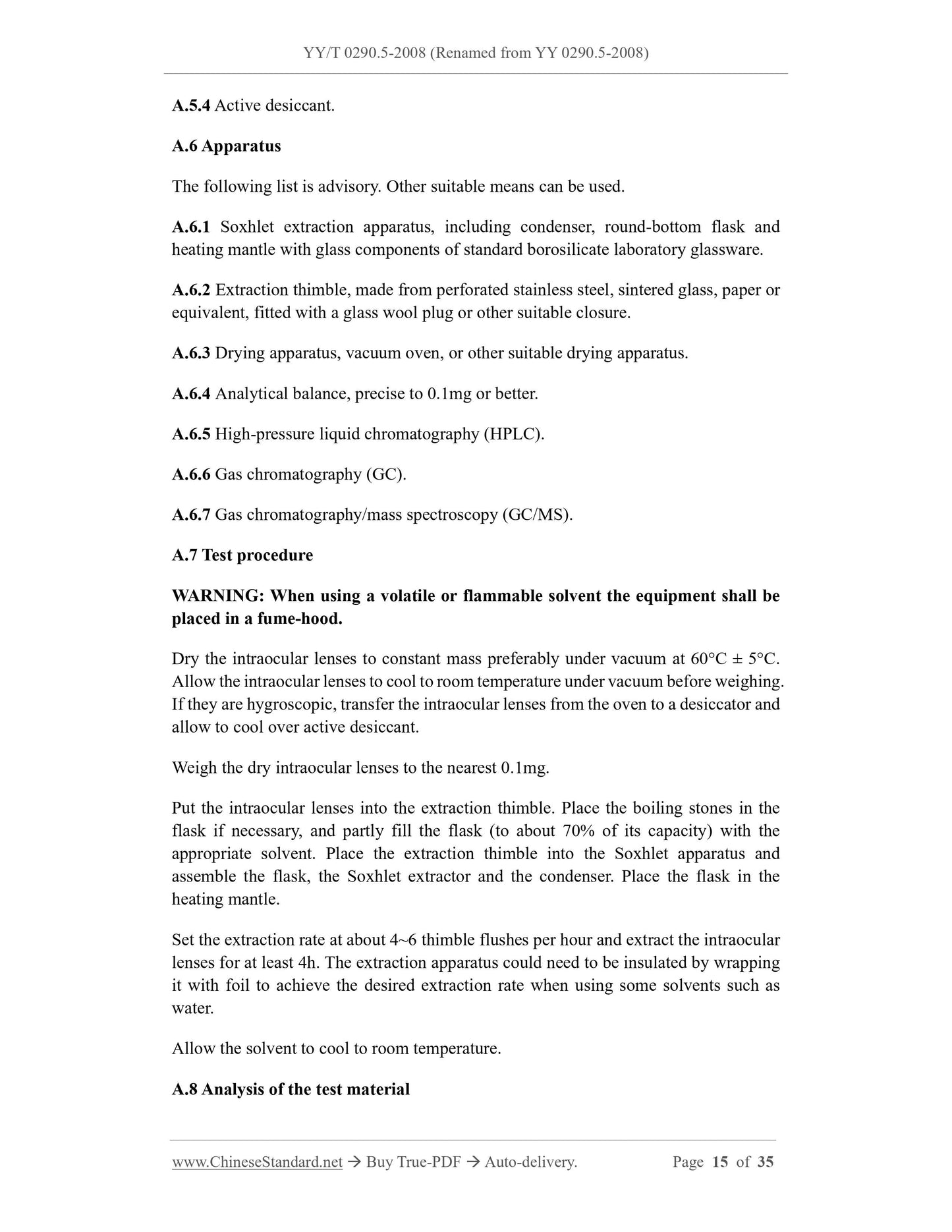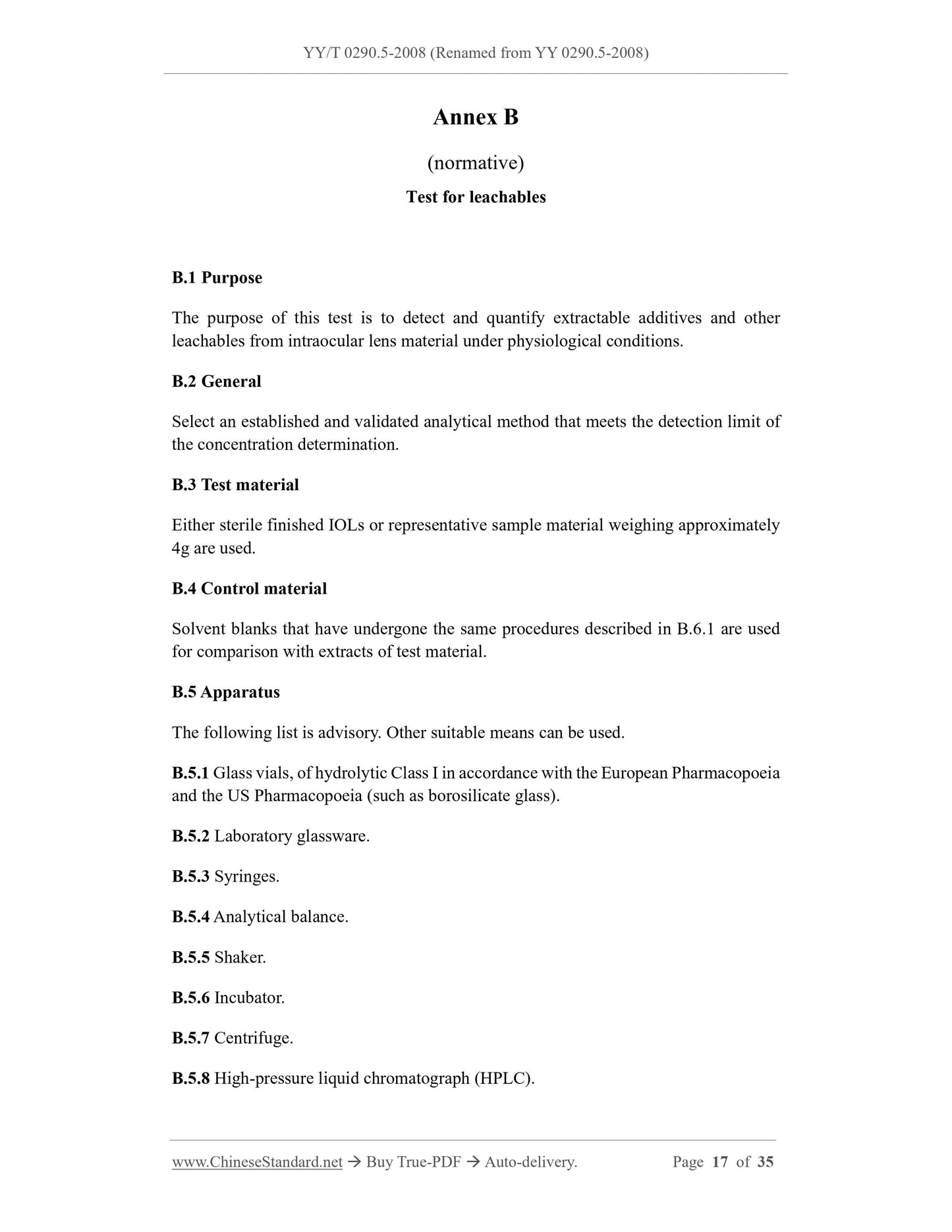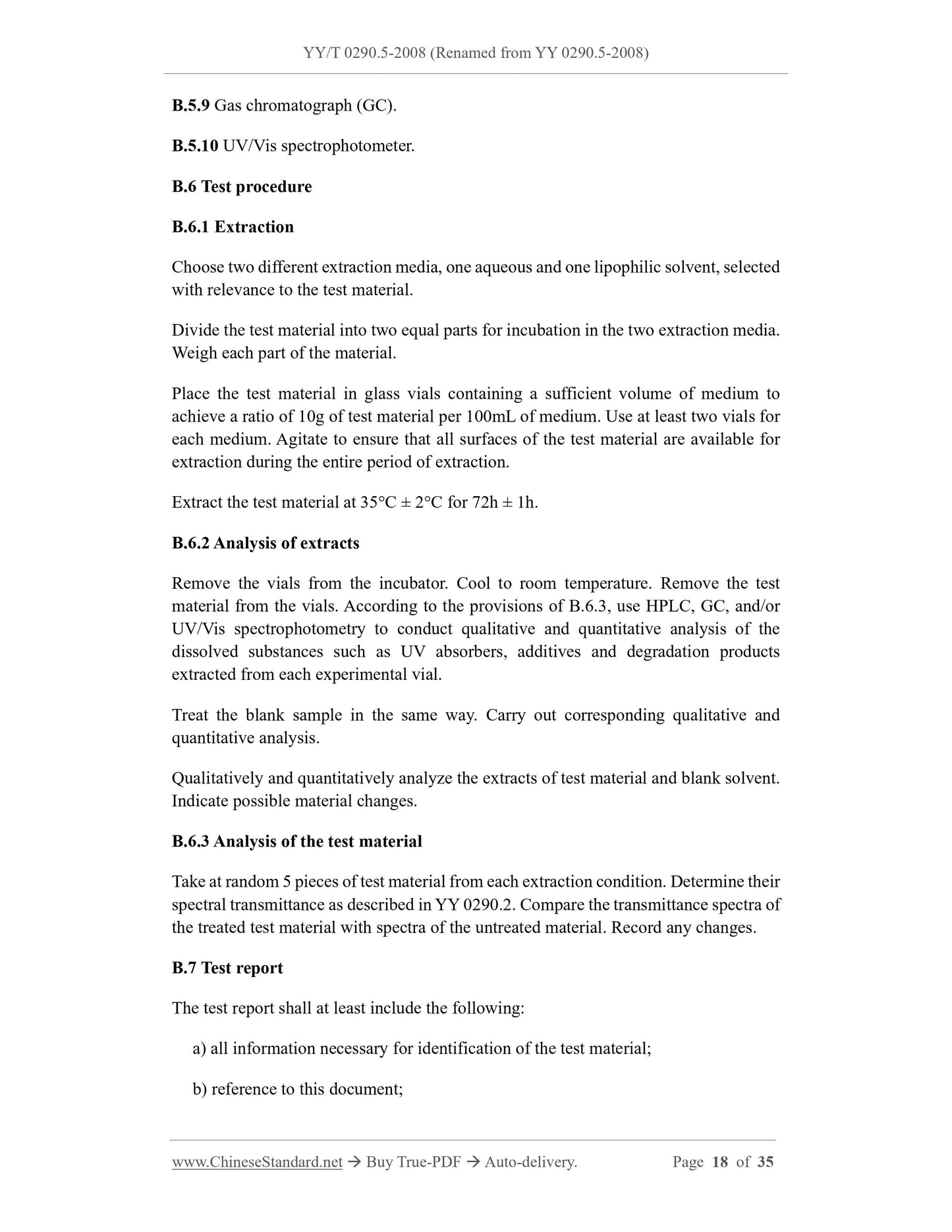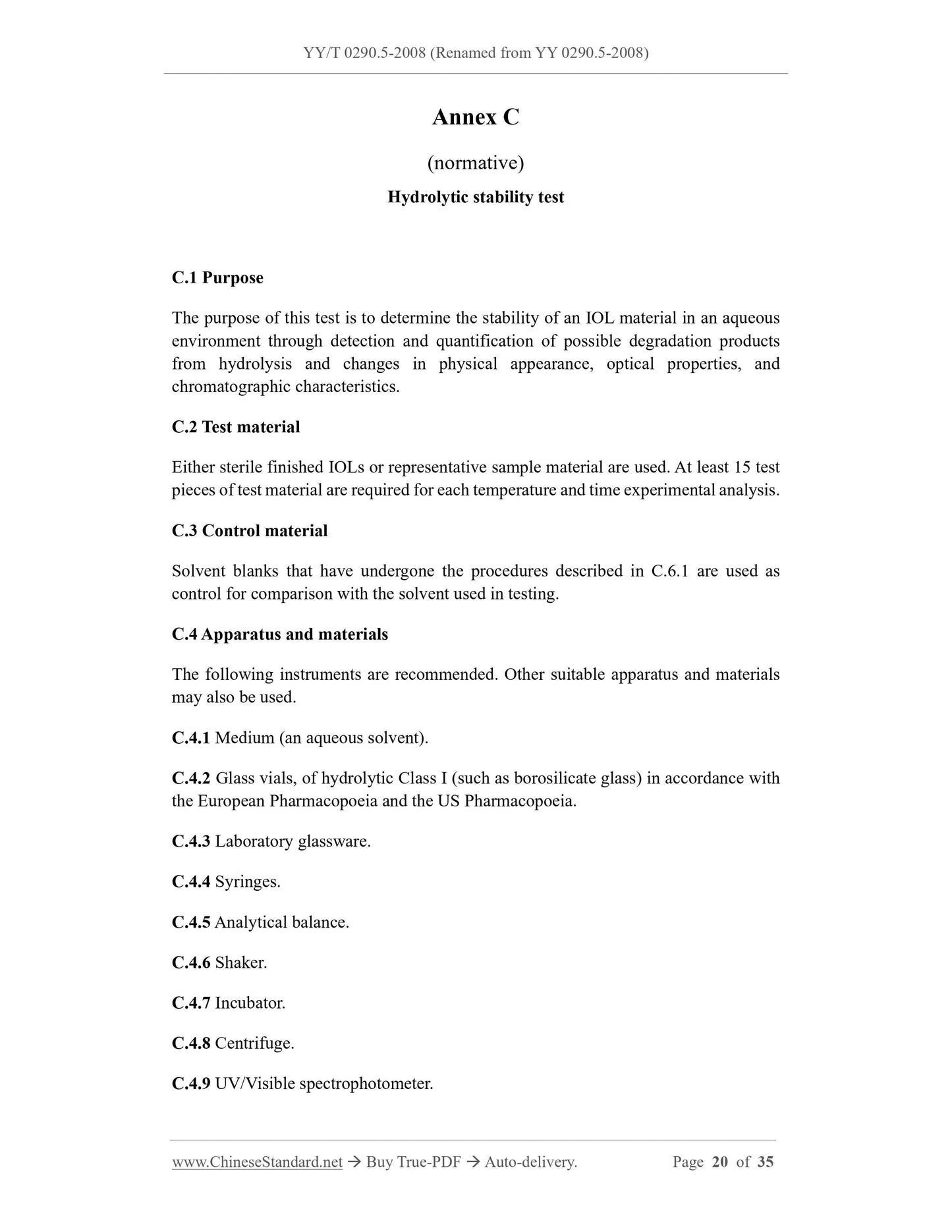PayPal, credit cards. Download editable-PDF and invoice in 1 second!
YY 0290.5-2008 English PDF (YY0290.5-2008)
YY 0290.5-2008 English PDF (YY0290.5-2008)
Precio habitual
$495.00 USD
Precio habitual
Precio de oferta
$495.00 USD
Precio unitario
/
por
Los gastos de envío se calculan en la pantalla de pago.
No se pudo cargar la disponibilidad de retiro
Delivery: 3 seconds. Download true-PDF + Invoice.
Get QUOTATION in 1-minute: Click YY 0290.5-2008
Historical versions: YY 0290.5-2008
Preview True-PDF (Reload/Scroll if blank)
YY 0290.5-2008: [YY/T 0290.5-2008] Ophthalmic implants. Intraocular lenses - Part 5: Biocompatibility
YY/T 0290.5-2008 (Renamed from YY 0290.5-2008)
YY
PHARMACEUTICAL INDUSTRY STANDARD
OF THE PEOPLE’S REPUBLIC OF CHINA
ICS 11.040
C 40
YY 0290.5-2008
Replacing YY 0290.5-1997
Ophthalmic implants - Intraocular lenses - Part 5:
Biocompatibility
(ISO 11979-5:2006, MOD)
ISSUED ON: OCTOBER 17, 2008
IMPLEMENTED ON: JUNE 01, 2010
Issued by: China Food and Drug Administration
According to the Announcement of the Medical Device Industry
Standard of National Medical Products Administration (No. 76, 2022),
this Standard will be converted into a recommendatory standard from
September 7, 2022. It will no longer be mandatory.
Table of Contents
Foreword ... 3
Introduction ... 5
1 Scope ... 6
2 Normative references ... 6
3 Terms and definitions ... 7
4 General requirements applying to biocompatibility evaluation of intraocular lenses 7
5 Physicochemical tests ... 8
6 Biological tests ... 11
Annex A (normative) Exhaustive extraction test ... 14
Annex B (normative) Test for leachables ... 17
Annex C (normative) Hydrolytic stability test ... 20
Annex D (normative) Photostability test ... 23
Annex E (normative) Nd-YAG laser exposure test ... 25
Annex F (informative) Supplemental conditions of test for local effects after
implantation ... 27
Annex G (normative) Ocular implantation test ... 28
Annex NA (informative) Technical differences between this Standard and ISO 11979-
5:2006 and their reasons ... 33
Bibliography ... 35
Ophthalmic implants - Intraocular lenses - Part 5:
Biocompatibility
1 Scope
This Part of YY 0290 specifies particular requirements for the biocompatibility
evaluation of materials for intraocular lenses (IOL) including the processing conditions
to produce them. These requirements include evaluation of physicochemical properties
that are relevant to biocompatibility. It also gives guidance on conducting an ocular
implantation test.
2 Normative references
The provisions in following documents become the provisions of this Part of YY 0290
through reference in this Part. For dated references, the subsequent amendments
(excluding corrigendum) or revisions do not apply to this Part, however, parties who
reach an agreement based on this Part are encouraged to study if the latest versions of
these documents are applicable. For undated references, the latest edition of the
referenced document applies.
GB/T 16886.1, Biological evaluation of medical devices - Part 1: Evaluation and
testing within a risk management process (GB/T 16886.1-2001, idt ISO 10993-
1:1997)
GB/T 16886.2, Biological evaluation of medical devices - Part 2: Animal welfare
requirements (GB/T 16886.2-2000, idt ISO 10993-2:1992)
GB/T 16886.3, Biological evaluation of medical devices - Part 3: Tests for
genotoxicity, carcinogenicity and reproductive toxicity (GB/T 16886.3-2003, ISO
10993-3:2003, IDT)
GB/T16886.6, Biological evaluation of medical devices - Part 6: Tests for local
effects after implantation (GB/T 16886.6-1997, idt ISO 10993-6:1994)
GB/T 16886.10, Biological evaluation of medical devices - Part 10: Tests for
irritation and skin sensitization (GB/T 16886.10-2005, ISO 10993-10:2002, IDT)
GB/T 16886.12, Biological evaluation of medical devices - Part 12: Sample
preparation and reference materials (GB/T 16886.12-2002, idt ISO 10993-12:2002)
YY 0290.1, Ophthalmic implants - Intraocular lenses - Part 1: Terminology (YY
0290.1-2008, ISO 11979-1:2006, MOD)
YY 0290.2, Ophthalmic optics - Intraocular lenses - Part 2: Optical properties and
test methods
YY 0290.3, Ophthalmic optics - Intraocular lenses - Part 3: Mechanical properties
and test methods (YY 0290.3-2008, ISO 11979-3:2006, IDT)
YY/T 0316, Medical devices - Application of risk management to medical devices
(YY/T 0316-2003, ISO 14971:2000, IDT)
ISO 10339, Ophthalmic optics - Contact lenses - Determination of water content of
hydrogel lenses
3 Terms and definitions
For the purposes of this Part of YY 0290, the terms and definitions defined in YY 0290.1
apply.
4 General requirements applying to biocompatibility
evaluation of intraocular lenses
The evaluation of the biocompatibility of the test material shall start with an initial
assessment of risk in accordance with YY/T 0316. The physicochemical tests described
in Clause 5 shall first be considered. The evaluation of the material for biological safety
shall then be undertaken in accordance with the principles and requirements of GB/T
16886.1 and GB/T 16886.2, taking into consideration the results from the
physicochemical tests.
Furthermore, the risk assessment shall include an assessment of the potential for
material changes such as calcification. This risk assessment shall consider the history
of clinical use of the material, and animal models to test the long-term stability of the
material.
Carry out the biocompatibility testing in accordance with GB/T 16886.1, GB/T 16886.3,
GB/T 16886.5, GB/T 16886.6, GB/T 16886.10 and as noted in this Part.
The pre-existing information on the material and all the information obtained in the
evaluation process shall be integrated in an overall risk benefit assessment in
accordance with YY/T 0316.
5 Physicochemical tests
5.1 General
5.1.1 The following physicochemical tests shall be considered:
a) exhaustive extraction;
b) leachables;
c) hydrolytic stability;
d) photostability;
e) stability against Nd-YAG laser exposure;
f) insoluble inorganics.
5.1.2 The objectives of this group of tests are:
a) to quantify possible residues from synthesis and additives or impurities from
manufacturing and packaging;
b) to quantify possible degradation products due to hydrolysis;
c) to quantify leachable chemical components;
d) to facilitate an analysis of any risks introduced by toxic products which may result
from processing, treatment in use, or ageing of the test material.
5.1.3 The results of the tests given in 5.1.1 and 5.1.2 shall be recorded and included in
the assessment for risk in accordance with YY/T 0316. If any of the above tests was not
performed, a rationale justifying this decision shall be documented.
5.2 Exhaustive extraction test
The test material shall be tested for extractables under exhaustive extraction conditions
in accordance with the method described in Annex A, which describes several
extraction conditions, including the extraction media, temperature and duration.
Alternate methods can be used provided that they have been validated.
The following shall be considered:
a) The reasons for selecting each solvent shall be justified and documented.
b) The extraction media shall be qualitatively and quantitatively analysed at the end
of extraction for possible extractable components of the material, such as process
contaminants, residual monomers, additives, and other extractable components.
To - the temperature of the inside of the eye (35°C).
c) Before and after the test, the test material shall be inspected under an optical
microscope with a power of not less than 10 times. Compared with the untreated
material, there shall be no obvious difference on the outer surface, such as air
bubbles, dendrites, cracks;
d) Before and after the test, the test material shall be tested and recorded for the
spectral transmittance in the ultraviolet and visible light bands. By comparing the
spectral transmittance diagrams, the spectral transmittance of the test material
does not change significantly...
Get QUOTATION in 1-minute: Click YY 0290.5-2008
Historical versions: YY 0290.5-2008
Preview True-PDF (Reload/Scroll if blank)
YY 0290.5-2008: [YY/T 0290.5-2008] Ophthalmic implants. Intraocular lenses - Part 5: Biocompatibility
YY/T 0290.5-2008 (Renamed from YY 0290.5-2008)
YY
PHARMACEUTICAL INDUSTRY STANDARD
OF THE PEOPLE’S REPUBLIC OF CHINA
ICS 11.040
C 40
YY 0290.5-2008
Replacing YY 0290.5-1997
Ophthalmic implants - Intraocular lenses - Part 5:
Biocompatibility
(ISO 11979-5:2006, MOD)
ISSUED ON: OCTOBER 17, 2008
IMPLEMENTED ON: JUNE 01, 2010
Issued by: China Food and Drug Administration
According to the Announcement of the Medical Device Industry
Standard of National Medical Products Administration (No. 76, 2022),
this Standard will be converted into a recommendatory standard from
September 7, 2022. It will no longer be mandatory.
Table of Contents
Foreword ... 3
Introduction ... 5
1 Scope ... 6
2 Normative references ... 6
3 Terms and definitions ... 7
4 General requirements applying to biocompatibility evaluation of intraocular lenses 7
5 Physicochemical tests ... 8
6 Biological tests ... 11
Annex A (normative) Exhaustive extraction test ... 14
Annex B (normative) Test for leachables ... 17
Annex C (normative) Hydrolytic stability test ... 20
Annex D (normative) Photostability test ... 23
Annex E (normative) Nd-YAG laser exposure test ... 25
Annex F (informative) Supplemental conditions of test for local effects after
implantation ... 27
Annex G (normative) Ocular implantation test ... 28
Annex NA (informative) Technical differences between this Standard and ISO 11979-
5:2006 and their reasons ... 33
Bibliography ... 35
Ophthalmic implants - Intraocular lenses - Part 5:
Biocompatibility
1 Scope
This Part of YY 0290 specifies particular requirements for the biocompatibility
evaluation of materials for intraocular lenses (IOL) including the processing conditions
to produce them. These requirements include evaluation of physicochemical properties
that are relevant to biocompatibility. It also gives guidance on conducting an ocular
implantation test.
2 Normative references
The provisions in following documents become the provisions of this Part of YY 0290
through reference in this Part. For dated references, the subsequent amendments
(excluding corrigendum) or revisions do not apply to this Part, however, parties who
reach an agreement based on this Part are encouraged to study if the latest versions of
these documents are applicable. For undated references, the latest edition of the
referenced document applies.
GB/T 16886.1, Biological evaluation of medical devices - Part 1: Evaluation and
testing within a risk management process (GB/T 16886.1-2001, idt ISO 10993-
1:1997)
GB/T 16886.2, Biological evaluation of medical devices - Part 2: Animal welfare
requirements (GB/T 16886.2-2000, idt ISO 10993-2:1992)
GB/T 16886.3, Biological evaluation of medical devices - Part 3: Tests for
genotoxicity, carcinogenicity and reproductive toxicity (GB/T 16886.3-2003, ISO
10993-3:2003, IDT)
GB/T16886.6, Biological evaluation of medical devices - Part 6: Tests for local
effects after implantation (GB/T 16886.6-1997, idt ISO 10993-6:1994)
GB/T 16886.10, Biological evaluation of medical devices - Part 10: Tests for
irritation and skin sensitization (GB/T 16886.10-2005, ISO 10993-10:2002, IDT)
GB/T 16886.12, Biological evaluation of medical devices - Part 12: Sample
preparation and reference materials (GB/T 16886.12-2002, idt ISO 10993-12:2002)
YY 0290.1, Ophthalmic implants - Intraocular lenses - Part 1: Terminology (YY
0290.1-2008, ISO 11979-1:2006, MOD)
YY 0290.2, Ophthalmic optics - Intraocular lenses - Part 2: Optical properties and
test methods
YY 0290.3, Ophthalmic optics - Intraocular lenses - Part 3: Mechanical properties
and test methods (YY 0290.3-2008, ISO 11979-3:2006, IDT)
YY/T 0316, Medical devices - Application of risk management to medical devices
(YY/T 0316-2003, ISO 14971:2000, IDT)
ISO 10339, Ophthalmic optics - Contact lenses - Determination of water content of
hydrogel lenses
3 Terms and definitions
For the purposes of this Part of YY 0290, the terms and definitions defined in YY 0290.1
apply.
4 General requirements applying to biocompatibility
evaluation of intraocular lenses
The evaluation of the biocompatibility of the test material shall start with an initial
assessment of risk in accordance with YY/T 0316. The physicochemical tests described
in Clause 5 shall first be considered. The evaluation of the material for biological safety
shall then be undertaken in accordance with the principles and requirements of GB/T
16886.1 and GB/T 16886.2, taking into consideration the results from the
physicochemical tests.
Furthermore, the risk assessment shall include an assessment of the potential for
material changes such as calcification. This risk assessment shall consider the history
of clinical use of the material, and animal models to test the long-term stability of the
material.
Carry out the biocompatibility testing in accordance with GB/T 16886.1, GB/T 16886.3,
GB/T 16886.5, GB/T 16886.6, GB/T 16886.10 and as noted in this Part.
The pre-existing information on the material and all the information obtained in the
evaluation process shall be integrated in an overall risk benefit assessment in
accordance with YY/T 0316.
5 Physicochemical tests
5.1 General
5.1.1 The following physicochemical tests shall be considered:
a) exhaustive extraction;
b) leachables;
c) hydrolytic stability;
d) photostability;
e) stability against Nd-YAG laser exposure;
f) insoluble inorganics.
5.1.2 The objectives of this group of tests are:
a) to quantify possible residues from synthesis and additives or impurities from
manufacturing and packaging;
b) to quantify possible degradation products due to hydrolysis;
c) to quantify leachable chemical components;
d) to facilitate an analysis of any risks introduced by toxic products which may result
from processing, treatment in use, or ageing of the test material.
5.1.3 The results of the tests given in 5.1.1 and 5.1.2 shall be recorded and included in
the assessment for risk in accordance with YY/T 0316. If any of the above tests was not
performed, a rationale justifying this decision shall be documented.
5.2 Exhaustive extraction test
The test material shall be tested for extractables under exhaustive extraction conditions
in accordance with the method described in Annex A, which describes several
extraction conditions, including the extraction media, temperature and duration.
Alternate methods can be used provided that they have been validated.
The following shall be considered:
a) The reasons for selecting each solvent shall be justified and documented.
b) The extraction media shall be qualitatively and quantitatively analysed at the end
of extraction for possible extractable components of the material, such as process
contaminants, residual monomers, additives, and other extractable components.
To - the temperature of the inside of the eye (35°C).
c) Before and after the test, the test material shall be inspected under an optical
microscope with a power of not less than 10 times. Compared with the untreated
material, there shall be no obvious difference on the outer surface, such as air
bubbles, dendrites, cracks;
d) Before and after the test, the test material shall be tested and recorded for the
spectral transmittance in the ultraviolet and visible light bands. By comparing the
spectral transmittance diagrams, the spectral transmittance of the test material
does not change significantly...
Share
